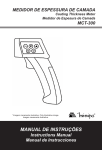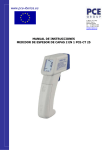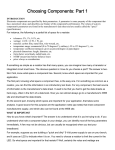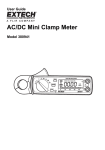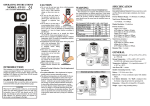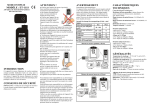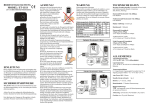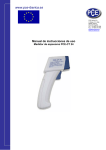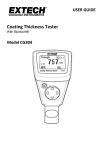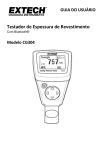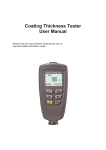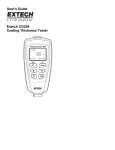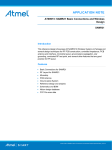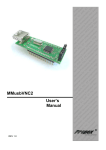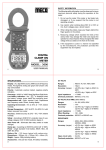Download model: pce-ct 25 introduction caution warning
Transcript
OPERATING INSTRUCTIONS MODEL: PCE-CT 25 2 IN 1 COATING THICKNESS GAUGE ● If the meter continues to use over one minute, the accuracy of the measurement of the higher thickness will become degraded. But the meter is still within its specified accuracy. ● Condensation may form on the sensor when going from a cold to hot environment. Wait for 10 minutes for condensation to dissipate before taking measurements. ● This unit is not constructed to be waterproof or dust proof. Do not use it in a wet or very dusty environment. ● In order to take accurate measurement, make sure the sensing tip contacts the coated surface tightly without tilting. ● Please make sure there is no air bubbles between substrate and coating. ● Substrate zeroing calibration must be implemented for each use. ● Two point calibration MUST implement for frequent testing points to increase measuring accuracy. WARNING INTRODUCTION This instrument is a portable easy to use 3½ digit, compact-sized digital “ferrous” or “non-ferrous” coating thickness gauge designed for simply one hand operation. Meter comes with backlight LCD display, Data Logging function and Auto Power Off (30 seconds approx.) to extend battery life. CAUTION ● Do not use the unit near any device which generates strong electromagnetic radiation or near a static electrical charge, like power generator, magnet…, as these may cause errors. ● Do not use the unit where it may be exposed to corrosive or explosive gases. The unit may be damaged, or explosion may occur. ● Do not keep or use this unit in an environment where it will be directly illuminated by sunshine, or where it condensation. If you do, it may be deformed, its insulation may be damaged, or it may no longer function according to specification. ● Do not place the meter on or around hot objects (70°C/158°F). It may cause damage to the case. ● If the meter is exposed to significant changes in ambient temperature, allow 30 minutes for temperature stabilization, before taking measurement. ELECTROMAGNETIC FIELD INTERFERENCE This instrument uses magnetic field method to measure the coating thickness on ferrous metal base. If this meter was placed in the environment with 20mG (mini Gauss) or above, the accuracy would be affected. Suggest that the meter should to put far away from the interfered source at least 30cm. Electromagnetic field strength: (※unit = mini Gauss) Electromagnetic Source 0cm 30cm Cellular Phone Charger 50 ~ 500 <1 Notebook Power Supply 100 ~ 1000 <5 LCD Display 10 ~ 100 <1 Fan 100 ~ 1000 <5 Reading Lamp 400 ~ 4000 < 10 ※Any product with coil inside should be considered. Recommended operating conditions (>30cm) Abnormal operating conditions (<30cm) DEFINITION Zeroing Plate Ferrous is steel Non-ferrous is Aluminum Standard Coating Plate SPECIFICATION GENERAL Display: 3½ digit liquid crystal display (LCD) wit maximum reading of 1999. Low Battery Indication: The “ ” is displayed when the battery voltage drops below the operating level. Measurement Rate: 1 second, nominal. Operating Environment: 32°F to 122°F (0°C to 50°C) at < 75% R.H. Storage Temperature: -4°F to 140°F (-20°C to 60°C), 0 to 80% R.H. with battery removed from meter. Auto Power Off: 30 seconds. Standby Consuming Current: < 15µA. Battery: Standard 9V battery (NEDA 1604, IEC 6F22 006P). Battery Life: 9 hours (continuity) typical (contain Backlit). Dimensions: 148mm (H) x 105mm(W) x 42mm(D). Weight: Approx. 157g (including battery). Detectable Substrate Material: Ferrous metal (iron, steel) and Non-Ferrous metal (copper, aluminum, zinc, bronze, brass, etc.) ELECTRICAL Thickness Range: 0 to 40.0mils (0 to 1000µm). Display Resolution: 0.1mils/1µm. Accuracy: ±4dgts on 0 to 7.8mils ±10dgts on 0 to 199µm ±(3%+4dgts) on 7.9mils to 40mils ±(3%+10dgts) on 200µm to 1000µm Temperature Coefficient: 0.1x (specified accuracy) / °C (< 18°C or > 28°C) Response Time: 1 second. ※Peel off the protection films from foil and standard coating plate before first use. FUNCTION KEY “ ” Use “ ” key to turn backlight on and off. “mils/µm” Use “mils/µm” key to switch between mils and µm. (1 mils = 25.4 µm) “Zero” 1. Quickly press “Zero” key (no longer than 2 seconds) for substrate zeroing calibration. 2. Hold “Zero” key (longer than 2 seconds) to calibrate frequent calibrating point. (Item 1 and 2, for detail, please see CALIBRATION) 3. Delete all calibration readings. 4. Delete MAX, MIN, and MAX-MIN readings. “MAX/MIN” 1. Use “MAX/MIN” key to switch maximum, minimum, max-min, average, and total counts of data log (MAX, MIN, MAX-MIN, AVG, and NO). 2. Capacity for data log is 255. Maximum, minimum, max-min, and average calculation will not be refreshed after 255th data. 3. When power is off, hold “MAX/MIN” key and pull the trigger to enter frequent calibrating point setting. 2. User may set the limits for application. Hold “CAL” when power is off. Pull trigger to power on and enter “SET Hi”. Adjust Hi limit by using ▲ or ▼. Confirm with “CAL” and enter “SET Lo”. Adjust Lo limit by using ▲ or ▼. Confirm again with “CAL” and the meter is ready for use. “CAL” 1. When power is off, hold down “CAL” key and pull the trigger to enter Hi/Lo limit alarm setting. 2. When power is on, and show the reading after measuring, hold down “CAL” key for one point calibration. 3. In data logging mode and frequent calibrating point setting, hold down “CAL” to confirm and return to operation. (Item 2 and 3, for detail, please see CALIBRATION) INSTRUCTION Power on and off: 1. Keep the sensing tip of the meter away from any substrate or any magnetic field. 2. Pull the trigger to turn on power. When LCD shows “run” and , the meter is ready for use. 3. Auto Power Off (APO) function: Leave the gauge without operation for 30 seconds, power turns off automatically. Auto Mode and Fixed Mode: 1. The meter is set to auto mode(Default), indicated as , which recognizes ferrous and non-ferrous substrate automatically. 2. If the substrate is fixed to ferrous or non-ferrous material, users may use fixed mode. When the power is off, button and pull the trigger to fix ferrous - Hold mode. - Hold “mils/µm” button and pull the trigger to fix non-ferrous mode. will not be shown. In the mean time, Hi/Lo Alarm Function: 1. Hi/Lo alarm function is always on to alert users. When the measurement is over high limit, alarm beeps 4 times; while the measurement is under low limit, alarm goes off continuously for 2.5 seconds. The Hi/Lo limit is defaulted 1200µm and 0µm. 4. Data logging counts in order starting from 1. Use ▲ to go to next data. Between first and last data, there is “CLr LoG” for clearance. Press “CAL” button will delete all logged data and return to operation. Please be aware that clearance function is not reversible. Be cautious before pressing “CAL” button. 5. Data storage capacity: 255. CALIBRATION Measuring: (Single and Continuous Mode) 1. Turn on the power. 2. Single Mode: Press the sensing tip to contact coated surface tightly. Pull the trigger (One sound “Beep” announced) and release immediately (Another sound “Beep” announced) sign appears when to have single measurement. measurement is completed. DO NOT remove the senssign is shown. ing tip from surface until 3. Continuous Mode: Pull the trigger(One sound “Beep” announced) and hold it, continuous measuring will be performed. Reading is refreshed every second. Release the trigger(Another sign to sound “Beep” announced) and wait for complete the last measuring. DO NOT remove the sign is shown. sensing tip from surface until ※No matter single or continuous mode, there are two sounds “beep” announced to complete the measurement. 4. Substrate material will be indicated accordingly as “Ferr” or “Non-Ferr”. If the substrate material can not (Same be recognized, the LCD shows “run” and with Power on), instead of “Ferr” and “Non-Ferr”. 5. APO is inactivated during continuous measuring. Data Logging: 1. Data logging automatically records the measuring results. During operating status, hold “mils/um” for 2 seconds. The meter goes to data logging mode, sign will be shown. Main readand ing indicates thickness measurement; sub-reading indicates data counts. 2. Use ▲ or ▼ to view previous or next data. After viewing, press “CAL” to exit data logging mode and return to operation. 3. When there is not any saved data, LCD shows “no dAtA”. The meter automatically exit data logging mode and return to operation. ※Before calibration, make sure the substrate material can be recognized by the meter. ※During calibration, Auto Power Off function will be extended to 2 minutes. Substrate Zeroing Calibration: 1. Power on. Press the sensing tip to contact uncoated substrate or foil (as attached accessory). Pull the trigger and release immediately to have single sign apmeasurement. Wait until pears. Quickly press “Zero” key (no longer than 2 seconds) to calibrate substrate material or foil. LCD displays 0 mils/µm. 2. After substrate zeroing, MAX, MIN, and MAX-MIN readings become zero. Step 1. Pull trigger Step 2. Display shows “run” Î Step 3. Put the measuring head on the substrate (Ferrous or Non-Ferrous) *And then pull trigger (Put the measuring head on the substrate) Step 4. Ferr stands for ferrous material. Î Step 5. Non-Ferr stands for Non-ferrous. Step 6. Press “Zero” key to make zeroing, and the display will show “0” One Point Calibration: ※Please have a thickness-known surface ready for one point calibration. Attached standard coating plate is 39.6 mils (1006µm). 1. Power on. Press the sensing tip to contact surface (Thickness-known surface or standard coating plate on sign aptop of foil). Pull the trigger and wait until pears. 2. Press “CAL” key and LCD will show “1-Pt”. Use ▲ or ▼ key to adjust reading until it matches the standard’s thickness. 3. Press “CAL” key again to exit calibration program and return to operation. Î Step 7. Place Standard Thickness 39.6mil/ 1006micron on the substrate Step 8. Pull trigger one time Î Two Point Calibration: ※There are two zeroing plates one is steel, and the other is Aluminum. Ferrous is steel, and Non-ferrous is Aluminum. Step 9. Please press “CAL” key Step 10. Display will show 2-Pt Î Step 11. Press Zero (▼) or MAX/MIN (▲) to adjust Display's values to 1006 um. See the Step 12. Step 12. Display's values to 1006 um. Î Step 13. Press “CAL” again Step 14. The 2-Pt will disappear, this means that the calibration is complete. And can start measuring Î OPERATION 1. Keep the meter away any substrate or any magnetic field. Pull the trigger to power on, and wait for “run” sign. and 2. Press the sensing tip to contact coated surface tightly. sign will 3. Pull the trigger and release immediately. appear when measurement is completed. DO NOT resign is move the sensing tip from surface until shown. 4. Substrate material will be indicated accordingly. If the substrate material can not be recognized, “Ferr” and “Non-Ferr” are not shown. 5. When the thickness is over the measurement range, the LCD will show the original data, and there is one sound “beep” announced. 6. Use “MAX/MIN” key to switch maximum, minimum, max-min, average, and number of data log. MAINTENANCE Battery Replacement Frequent Calibrating Point Setting: 1. When power is off, hold “MAX/MIN” key and pull the trigger to power on. 2. LCD shows “SET” and “dFut”. Wait for 2 seconds until it shows reading of frequent calibrating point. eg. 39.6 mils (1006µm). 3. Use ▲ or ▼ key to adjust reading until it matches the frequent calibrating point. Press “CAL” key again to exit calibration program and return to operation. This thickness point will be saved to the meter. Users do not have to set this calibrating point every time. 1. Power is supplied by a 9 volt “transistor” battery (NEDA 1604, IEC 6F22). If the LCD shows “ ”, it means the battery replacement is need. 2. Pull off battery cover “ ”. 3. Remove the battery cover by gently sliding it onwards the bottom of the meter. 4. Remove and disconnect the old battery from the meter and replace with a new unit. Wind the excess lead length and put the top of battery beneath the battery chamber. Install the battery and put the battery cover. Cleaning Periodically wipe the case with a damp cloth and detergent, do not use abrasives or solvents. Calibration on Frequent Calibrating Point: 1. Press the sensing tip to contact frequent calibrating surface on the substrate. Pull the trigger and wait until sign appears. 2. Hold “Zero” key for longer than 2 seconds. The meter will calibrate automatically to match the frequent calibrating point, which was saved in the meter earlier. Calibrating Point Clearance: 1. When power is off, hold “Zero” key and pull the trigger to power on. LCD shows “Clr” and “Set”. The zeroing point, one point, or two point calibration readings will be deleted. 2. When calibration is not operated properly, the clearance function helps users to start over again. Ä Caution Ver 1.7 02/14/11




